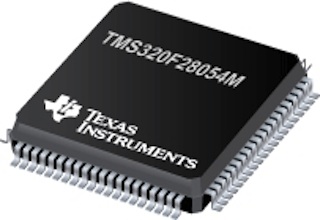 Specialized microcontrollers (or MCUs) are making it easier for engineers to design motor controllers. A new addition to Texas Instruments’ (TI) line of 32-bit MCUs is said to provide scalability and efficiency in analog system designs as well as significantly reducing design time.
Specialized microcontrollers (or MCUs) are making it easier for engineers to design motor controllers. A new addition to Texas Instruments’ (TI) line of 32-bit MCUs is said to provide scalability and efficiency in analog system designs as well as significantly reducing design time.
The latest devices, C2000 Piccolo TMS320F2805x MCUs, are equipped with InstaSPIN-FOC (field-oriented control) and InstaSPIN-MOTION motor control technology on the read-only memory (ROM) of the chip, which helps cut development time. The MCUs are optimized for a variety of three-phase sensored or sensorless motor control applications to control speed and improve efficiency, performance, and reliability of electric pumps, fans, traction drives, and more. The MCUs also pack a number of analog components on chip to increase system efficiency and decrease the number of discrete parts required in a motor system design. Designers can also choose package size, number of pins, memory, clock speed, and control and communication peripherals.
“Our new Piccolo F2805x MCUs with InstaSPIN-FOC and MOTION are the most recent products showcasing TI’s commitment and leadership in motor control technology over the last 20 years,” said Chris Clearman, worldwide manager, motor control solutions, TI.
The InstaSPIN-FOC and MOTION allows designers to eliminate a lot of the motion control challenges in traditional motor systems with by providing the expertise on-chip and removing the need for inefficient, older design techniques.
Specifically, the embedded InstaSPIN-MOTION SpinTAC components can be used to ensure optimum tracking and disturbance rejection, working with the real inertia of the system. They also help to minimize effort and reduce complexity with single coefficient tuning, allowing designers to rapidly test and tune velocity control from soft to stiff response, defining a controller gain that typically works across the entire variable speed and load range of an application. Designers can also actively estimate and cancel system disturbances in real time, providing maximum performance. These features help produce an automatically optimized motion profile based on start velocity, target velocity and system limitations for acceleration, jerk and motion trajectory type. This lets designers quickly build various states of motion (speed A to speed B) and tie them together with state-based logic.
The CPU runs at 60 MHz with embedded memory for more storage, including up to 128 KB Flash and up to 20 KB SRAM. Boot ROM and 128-bit security key on protected zones for both Flash and ROM ensure code security for the entire device or mixed-source software development. Plus, on-chip communication interfaces, such as an SPI module, I2C bus, CAN 2.0 and three SCI/UART modules improve connectivity for real-time communications.
In addition, integrated analog control peripherals improve system efficiency and reduce bill of materials cost, including 12-bit analog-to-digital converter (ADC), 14 enhanced pulse-width-modulation (PWM) channels with fault management, seven windowed analog comparators with 10-bit digital-to-analog converters (DACs), dual zero-pin oscillators, voltage regulator, up to four programmable gain amplifiers (PGAs) and 3 fixed-gain amplifiers, and 32-bit enhanced input capture module (eCAP) and enhanced quadrature encoder pulse (eQEP) for rotor sensor interface.
Evaluate quickly and easily using the compatible C2000 F28054M controlCARD motor control library through the MotorWare software infrastructure, which offers the latest in C object-oriented and API-based coding techniques and lab-based projects and documentation.
To find out more, visit TI’s microcontroller overview page.


Leave a Reply
You must be logged in to post a comment.